Papyrus roll-tied
The ancient Egyptian Papyrus roll-tied and sealed hieroglyph comes in the common horizontal, or a vertical form (shown in photo). It is juxtaposed against an open scroll, the Papyrus roll-open hieroglyph,
| Papyrus Roll- -Tied m(dj)3t in hieroglyphs | |||||||
|---|---|---|---|---|---|---|---|
, without the "visible ties". The sealed form can also have a seal impressed (in clay) on the tie, for security, or authentication, (see notarization). Both styles of the papyrus roll, "-tied" or "-open", are an ideogram for "roll of papyrus", with a phonetic value of m(dj)3t.[1]
Some artistic versions of the papyrus roll show the laminations, or grid-work, the cross-hatching of the papyrus fibers, for example on Thutmose III's cartouches.
Gallery
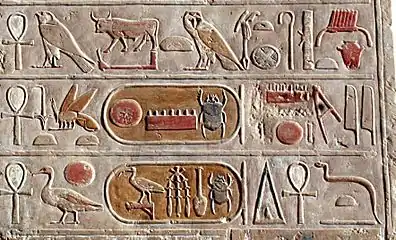 Painted Thutmosis III cartouches (temple relief), Deir el-Bahari.
Painted Thutmosis III cartouches (temple relief), Deir el-Bahari.
(end of line 1, reads left-to-right)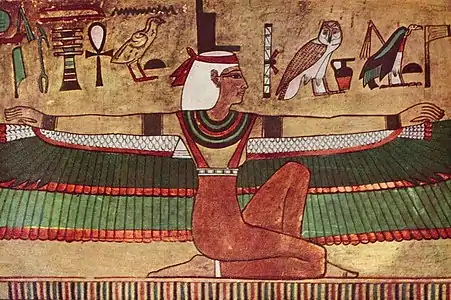 Finely painted Egyptian hieroglyph sample
Finely painted Egyptian hieroglyph sample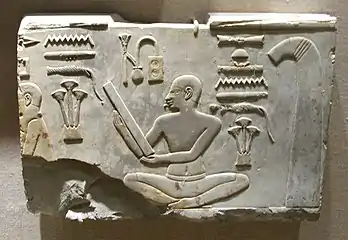 Finely detailed limestone relief example of tied papyrus hieroglyph
Finely detailed limestone relief example of tied papyrus hieroglyph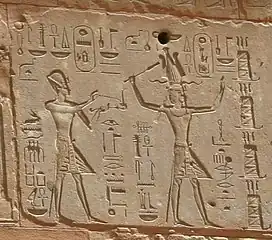
 Detail of Hare and water-ripple quadrat (hieroglyph block)
Detail of Hare and water-ripple quadrat (hieroglyph block) Vertical text, hare hieroglyph at beginning
Vertical text, hare hieroglyph at beginning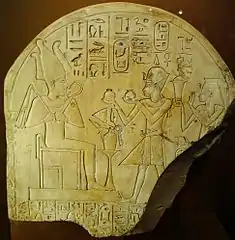 Partially missing lunette of a stela; Finely executed in shallow, incised-bas relief
Partially missing lunette of a stela; Finely executed in shallow, incised-bas relief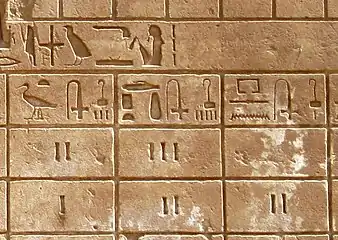 Example of tied papyrus roll, Karnak.
Example of tied papyrus roll, Karnak.
(in top row, "standard" horizontal form)
(Note also brazier (hieroglyph))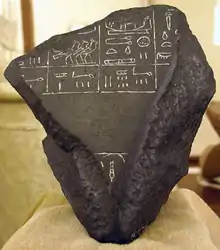 Untied version of papyrus roll from Palermo Stone fragment.
Untied version of papyrus roll from Palermo Stone fragment.
(Note: also with "no top appendage" on scroll (a subset variety of the "papyrus roll").
See also
Wikimedia Commons has media related to Papyrus roll-tied (hieroglyph).
References
- Betrò, 1995. Hieroglyphics: The Writings of Ancient Egypt, p. 237.
- Betrò, 1995. Hieroglyphics: The Writings of Ancient Egypt, Betrò, Maria Carmela, c. 1995, 1996-(English), Abbeville Press Publishers, New York, London, Paris (hardcover, ISBN 0-7892-0232-8)
- Budge, (1920), 1978. An Egyptian Hieroglyphic Dictionary, E.A.Wallace Budge, (Dover Publications), c 1978, (c 1920), Dover edition, 1978. (In two volumes, 1314 pp. and cliv-(154) pp.) (softcover, ISBN 0-486-23615-3)
This article is issued from Wikipedia. The text is licensed under Creative Commons - Attribution - Sharealike. Additional terms may apply for the media files.